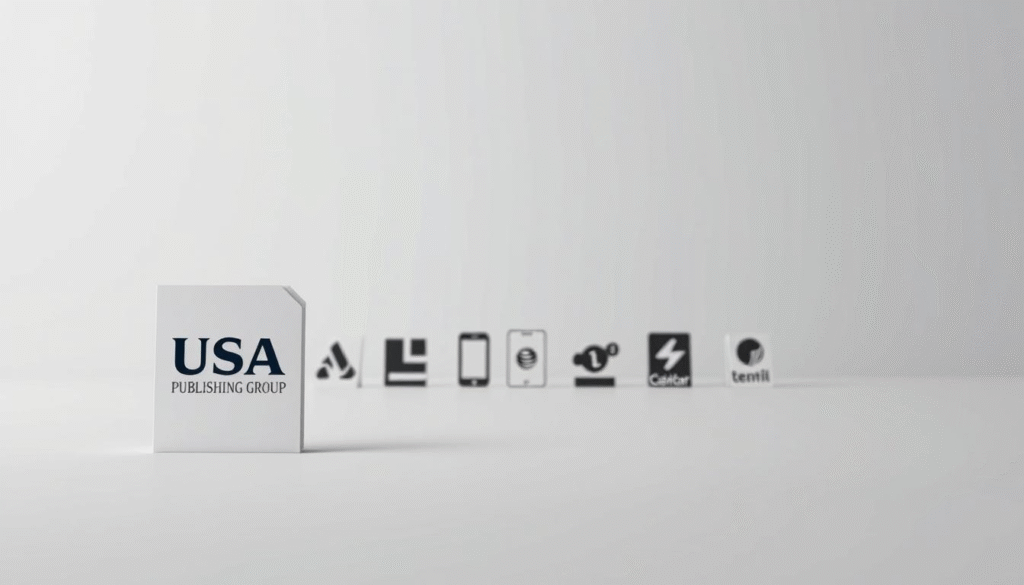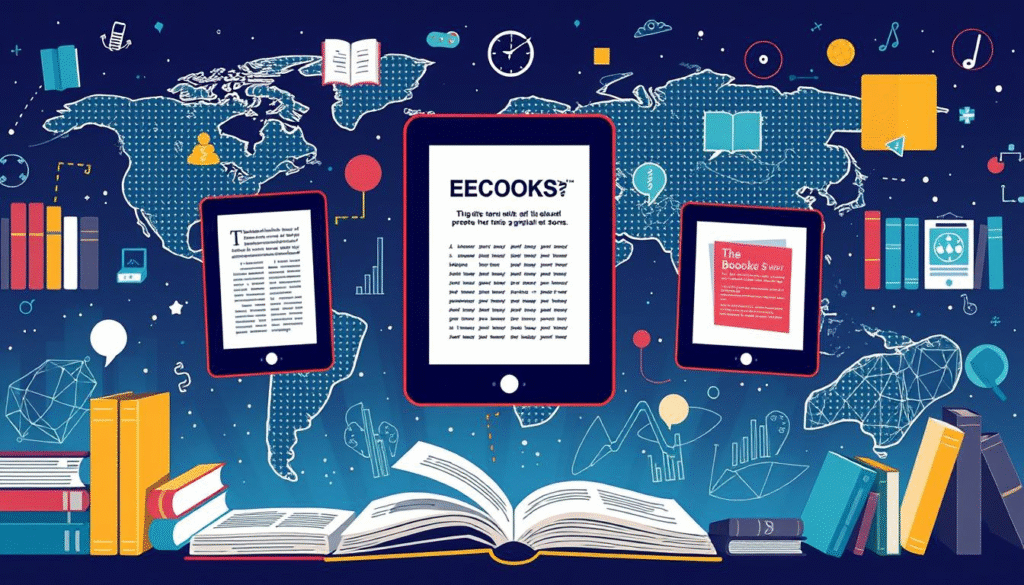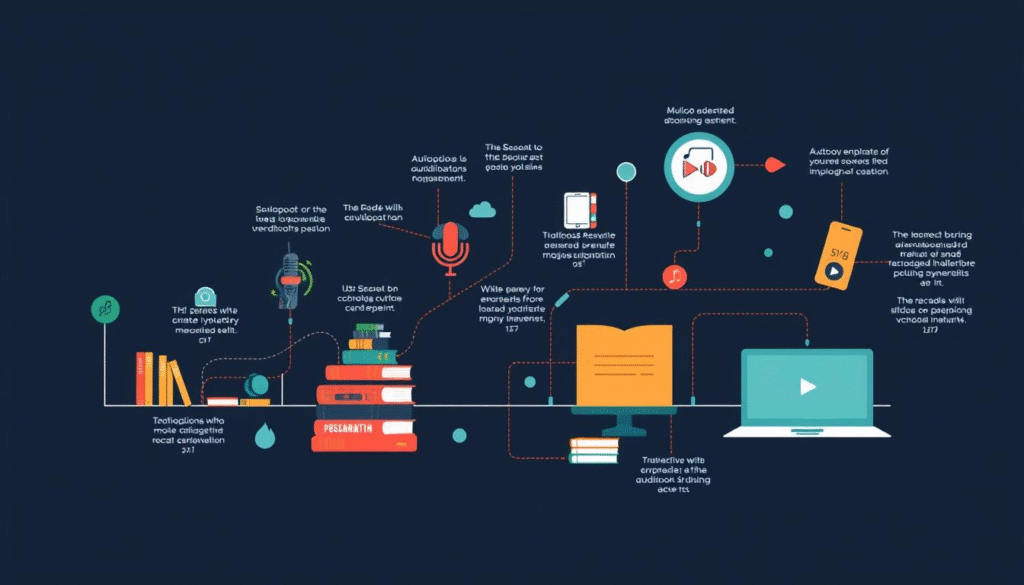Are you an aspiring author wondering if you’re missing out on potential readers by choosing the wrong eBook publishing platform?
With numerous companies advertising their services to self-publishing authors, it’s crucial to verify the trustworthiness of a publishing company before making a decision. The digital publishing landscape offers vast opportunities for authors to share their work globally.

Choosing the right platform can significantly impact an author’s success, affecting royalty rates, market reach, and promotional opportunities. This guide will explore the most effective eBook publishing options available in 2025.
Key Takeaways
- Understanding the different types of eBook publishing platforms available.
- Comparing features, benefits, and potential drawbacks of each platform.
- Identifying the best platforms for different author goals and target audiences.
- Actionable insights for maximizing publishing success.
- Tips for verifying the trustworthiness of a self-publishing company.
Understanding eBook Publishing Options
The world of eBook publishing is vast and varied, offering authors multiple paths to reach their readers. eBook retailers are online bookstores where you can upload and sell your book directly to customers. While Amazon is the best-known eBook retailer, there are other reputable alternatives depending on your audience and needs.
Book aggregators act as distributors, simplifying the publishing process by sending your book to dozens of stores on your behalf. Instead of uploading your eBook to multiple retailers one by one, you submit it to an aggregator, which saves time and streamlines the process.
Direct Retailers vs. Aggregators
The eBook publishing landscape is divided into two main categories: direct retailers and aggregators, each offering distinct advantages for authors. Direct retailers like Amazon KDP, Apple Books, and Barnes & Noble Press allow authors to upload their eBooks directly to these specific platforms, typically offering higher royalty rates but requiring individual account management for each store.
- Direct retailers offer higher royalty rates but require more management.
- Aggregators simplify the publishing process but take a small percentage of sales.
- Understanding the difference between these two approaches helps authors develop a strategic distribution plan.
The choice between direct publishing and using aggregators often depends on an author’s specific goals, technical comfort level, and how much time they can dedicate to managing multiple platform accounts. By understanding the options available, authors can make informed decisions about their eBook distribution strategy.
The Best eBook Publishing Platforms for Self-Published Authors

With the rise of self-publishing, authors now have access to a variety of eBook publishing platforms. These platforms offer different benefits, from royalty rates to marketing tools, making it crucial for authors to choose the ones that best fit their needs.
How We Evaluated These Platforms
When evaluating the best eBook publishing platforms for self-published authors, we considered several critical factors, including royalty rates, market reach, ease of use, and available marketing tools. Our assessment focused on platforms that provide the greatest value to authors through a combination of favorable royalty structures, wide distribution networks, and user-friendly interfaces.
Key Factors for Success
The key factors for publishing success include selecting platforms that align with your target audience’s reading habits, understanding each platform’s unique promotional opportunities, and developing a strategic approach to pricing and distribution. For new authors, ease of use and customer support quality are particularly important considerations when choosing a publishing platform.
Experienced authors may prioritize advanced marketing tools, detailed analytics, and the ability to run targeted promotions across multiple platforms simultaneously. The most successful self-published authors often utilize a combination of direct retailers and aggregators to maximize both their reach and revenue potential.
Amazon Kindle Direct Publishing (KDP)

For self-published authors, Amazon Kindle Direct Publishing (KDP) remains a crucial platform for reaching a vast audience. Launched in 2007, KDP has become the go-to service for authors looking to publish their ebooks on the world’s largest online bookstore.
Overview
Amazon Kindle Direct Publishing offers a free, user-friendly platform for authors to publish their ebooks. With a global reach and a significant market share, KDP is an essential channel for authors seeking to maximize their ebook sales. The platform is part of Amazon’s broader strategy to dominate the ebook market, which it largely controls with a 68% global market share.
Pros
The primary advantage of using KDP is its vast market reach. Authors can access millions of potential readers through Amazon’s powerful recommendation algorithms. Additionally, KDP offers a straightforward publishing process, with 70% royalties on ebooks priced between $2.99 and $9.99. The optional KDP Select program provides promotional tools and access to Kindle Unlimited subscribers in exchange for 90 days of digital exclusivity.
Cons
Despite its dominance, Amazon KDP has several drawbacks. The platform is highly competitive, making it challenging for new authors to gain visibility. Furthermore, some authors have expressed dissatisfaction with Amazon’s customer service. Authors must also consider the exclusivity requirements of KDP Select and weigh these against the potential benefits of publishing across multiple platforms.
Royalty Structure and Pricing
KDP’s royalty structure is designed to incentivize authors to price their ebooks between $2.99 and $9.99, offering 70% royalties within this range. For ebooks priced outside this range, authors earn 35% royalties. This structure allows authors to maximize their earnings while also giving them flexibility in pricing their work.
In conclusion, Amazon Kindle Direct Publishing (KDP) is a powerful tool for self-published authors. While it offers significant benefits in terms of market reach and royalty earnings, authors must carefully consider its limitations and the implications of the KDP Select program.
Apple Books

Overview
Apple Books is a significant eBook publishing platform that offers authors a unique opportunity to reach readers within the Apple ecosystem. Launched in 2010, it has become a go-to option for many authors, especially those targeting a younger demographic. With a global reach, albeit restricted to Apple users, Apple Books provides a dedicated audience for eBook distribution.
Pros
High Royalty Rates: Apple Books offers a flat 70% royalty rate on all eBooks, regardless of the price point, making it an attractive option for authors. The platform is also free to use, with no exclusivity requirements, allowing authors to maintain control over their work.
Apple Books is particularly appealing to younger readers, making it an excellent choice for authors whose work targets this demographic. The platform’s integration with Apple devices ensures a seamless reading experience, enhancing reader engagement.
Cons
The primary limitation of Apple Books is its restricted reach, as it is only accessible to Apple device users. This represents a smaller market share compared to Amazon’s cross-platform availability. Additionally, direct publishing to Apple Books requires Apple hardware, which can be a hurdle for authors without Mac computers.
Royalty Structure and Pricing
The royalty structure on Apple Books is straightforward, with authors earning 70% on all eBook sales. This rate applies across all price points, providing a consistent income stream. The platform’s pricing is competitive, allowing authors to set prices that are attractive to their target audience.
Barnes & Noble Press

Overview
Barnes & Noble Press is the self-publishing arm of America’s largest physical book retailer, offering authors a direct channel to list their ebooks on the Nook platform. Established in 2010, it has evolved from its predecessors, PubIt! and Nook Press, to become a significant player in the self-publishing landscape. With its primary focus on the United States market, Barnes & Noble Press provides a valuable service for authors targeting American readers.
Pros
One of the standout features of Barnes & Noble Press is its royalty structure, offering authors a flat 70% rate on all ebooks regardless of price point. This is competitive with other major platforms like Apple Books and exceeds Amazon’s standard offerings. Additionally, Barnes & Noble Press is known for its fast royalty payments, with authors receiving their earnings just 30 days after the end of the sales month. The platform also offers integrated print-on-demand services, allowing authors to create physical books that can be ordered by Barnes & Noble’s brick-and-mortar stores.
Cons
Despite its advantages, Barnes & Noble Press has a limited market share compared to Amazon, and its reach is primarily confined to the United States. This can be a significant limitation for authors seeking a global audience. Nonetheless, for those targeting American readers, Barnes & Noble Press remains a viable option.
Royalty Structure and Pricing
The royalty rate of 70% on all ebooks is a major draw for authors. With no upfront costs to authors, Barnes & Noble Press is an attractive platform for those looking to sell books directly to readers. The simplicity of its pricing model, combined with fast payment processing, makes it an appealing choice for many self-published authors.
Kobo Writing Life

Overview
Kobo Writing Life is a significant player in the eBook publishing landscape, offering authors a global marketplace with a strong presence in Canada, Europe, Australia, and New Zealand. Since its inception in 2012, it has become a vital platform for self-published authors. Owned by Rakuten Kobo, a Canadian company, Kobo Writing Life makes eBooks accessible to readers in over 190 countries.
Pros
Competitive Royalty Structure: Kobo Writing Life offers authors a competitive royalty structure, with 70% royalties on eBooks priced at $2.99 and higher, and 45% for eBooks priced below $2.99. The platform also provides excellent promotional tools that don’t require exclusivity, allowing authors to benefit from featured placements while still publishing on other platforms.
Authors who publish directly through Kobo Writing Life gain access to additional promotional opportunities, significantly boosting their visibility.
Cons
One of the main challenges authors face with Kobo Writing Life is its smaller market share in the United States. To effectively reach American readers, authors will need to combine Kobo with other publishing platforms.
Royalty Structure and Pricing
The royalty structure is based on the eBook’s pricing. For eBooks priced at $2.99 or higher, authors earn 70% royalties. For those priced below $2.99, the royalty drops to 45%. This pricing strategy allows authors to maximize their earnings by strategically pricing their eBooks.
Top eBook Aggregators for Wider Distribution

For authors seeking to expand their eBook’s reach, top eBook aggregators offer a valuable service that simplifies distribution across multiple platforms. eBook aggregators provide a crucial link between authors and major retailers, making it easier for authors to get their work noticed.
Two industry leaders have emerged in the eBook aggregator space: Draft2Digital and PublishDrive. Both offer unique benefits that cater to different author needs.
Draft2Digital
Draft2Digital (D2D) has been a significant player in the eBook distribution landscape since 2012. It offers authors a user-friendly experience with excellent customer support and a sleek dashboard. D2D distributes eBooks to major retailers like Amazon, Apple Books, Barnes & Noble, and Kobo, as well as hundreds of other stores and libraries.
One of the key advantages of D2D is its automated back matter feature, which updates all your books when you publish something new, creating a connected catalog that helps drive readers from one book to another. The service is free for authors, with Draft2Digital taking 10% of the retail price as their royalty share.
PublishDrive
PublishDrive, launched in 2015, distinguishes itself with a unique subscription-based model. Authors pay a flat monthly fee rather than a percentage of sales, making it particularly cost-effective for authors with higher sales volumes. This model allows authors to keep 100% of their royalties after paying the subscription fee.
PublishDrive also provides access to emerging markets, including China, which can be challenging to reach through other services. It distributes eBooks to major retailers like Amazon, Apple Books, Google Play, Barnes & Noble, and Kobo, along with hundreds of other platforms.
Both Draft2Digital and PublishDrive offer valuable services for authors seeking wide distribution. The choice between them may depend on the author’s sales expectations and the specific retailers they wish to target.
Print-on-Demand Options for Authors

For authors looking to expand their reach beyond ebooks, print-on-demand options offer a flexible and cost-effective solution. Print-on-demand (POD) services have revolutionized self-publishing by eliminating the need for large print runs and inventory management, allowing authors to offer physical books alongside their ebooks with minimal upfront investment.
Cost-Effective Printing with KDP Print
KDP Print, Amazon’s integrated POD service, offers authors the most cost-effective printing options and direct access to Amazon’s massive customer base, making it the default choice for many self-published authors. The service provides royalty rates of 60% for books priced at $9.99 or higher (minus printing costs), with expanded distribution options that can place your print books in bookstores and libraries beyond Amazon.
Premium Distribution with IngramSpark
IngramSpark stands as the premium alternative to KDP Print, offering higher print quality, more format options, and unparalleled distribution to thousands of bookstores, libraries, and academic institutions worldwide. While IngramSpark’s printing costs are higher and its interface less user-friendly than KDP Print, it remains the preferred choice for authors seeking bookstore placement due to its industry reputation and relationships with brick-and-mortar retailers.
Many experienced authors utilize both KDP Print and IngramSpark simultaneously—using KDP Print for Amazon sales to maximize royalties and IngramSpark for expanded distribution to physical bookstores and libraries. This strategic combination allows authors to reach a wide global audience while also getting their books into brick-and-mortar stores.
Audiobook Distribution Platforms

As the popularity of audiobooks continues to rise, authors are seeking effective distribution platforms. The audiobook market is booming, with 51% of Americans having listened to an audiobook, creating vast opportunities for authors to expand their reach beyond traditional eBook and print formats.
The rise of audiobooks has led to the emergence of new distribution platforms. Two notable platforms are Spotify for Authors and Voices by INaudio, each offering unique benefits to authors.
Spotify for Authors
Spotify for Authors is a relatively new but rapidly growing platform in the audiobook space. Launched in 2024, it offers authors direct access to Spotify’s 696 million users worldwide. The platform provides sophisticated marketing analytics, enabling authors to track their performance and adjust their strategies accordingly.
Spotify has seen a 35% increase in audiobook listening hours between January 2024 and January 2025, indicating strong growth potential. While Amazon’s Audible still dominates the audiobook scene, Spotify’s growth is noteworthy.
Voices by INaudio
Voices by INaudio provides authors with wide audiobook distribution while allowing them to retain 100% of their Spotify royalties. This makes it an attractive option for authors already using Spotify for Authors. Unlike Amazon KDP’s audiobook service (ACX), which has restrictive policies, Voices by INaudio offers more flexible terms and greater control over pricing and distribution.
Authors looking to maximize their audiobook reach should consider a strategic approach that combines direct distribution through Spotify with wider distribution through aggregator services like Voices by INaudio. The production quality of audiobooks remains crucial to success, with professional narration and sound design making a significant difference in listener experiences.
Conclusion: Choosing the Right Publishing Platform for Your Needs
Choosing the right publishing platform is a crucial decision for authors in today’s digital landscape. With numerous options available, it’s essential to consider your specific goals, target audience, and the unique strengths of each service.
For most authors, a hybrid approach combining direct publishing to major retailers like Kindle Direct Publishing with wider distribution through aggregators often yields the best results. This strategy allows authors to maximize their reach while maintaining control over their work.

When selecting a publishing platform, consider factors such as your target audience’s reading preferences, your marketing strategy, desired royalty rates, and the time you’ll need to invest in managing multiple platforms. Authors focusing primarily on the US market may prioritize Amazon KDP for its dominant market share, while those targeting international readers should consider platforms like Kobo Writing Life and Apple Books alongside their Amazon presence.
| Platform | Target Audience | Royalty Rate |
| Amazon KDP | US Market | Up to 70% |
| Kobo Writing Life | International | Up to 70% |
| Apple Books | Global | Up to 70% |
Remember that publishing platforms are tools, not destinations—the quality of your book, combined with effective marketing, will ultimately determine your success regardless of which platforms you choose. If you need personalized guidance on selecting the right publishing platforms for your specific needs, our team at USA Publishing Group is available to help you navigate these choices and develop a customized publishing strategy. Contact us at support@usapublishinggroup.com or +1 682 681 8050 for more information.
Contact USA Publishing Group for Professional Publishing Support
For authors seeking professional guidance in navigating the complex eBook publishing landscape, USA Publishing Group is a trusted partner. With a deep understanding of the publishing industry, we offer comprehensive support tailored to your specific publishing goals.
Our team of publishing professionals can help you evaluate which eBook publishing platforms best suit your book’s genre, target audience, and marketing strategy. By maximizing both reach and royalty potential, we ensure that your publishing efforts are optimized for success.
We provide assistance with all technical aspects of publishing, including formatting your manuscript for various platforms, designing compelling covers that meet each platform’s specifications, and optimizing your book’s metadata for discoverability. For authors seeking wider distribution, we can manage the entire publishing process across multiple platforms, handling everything from initial setup to ongoing sales monitoring and royalty collection.
Our services extend beyond digital publishing to include print-on-demand coordination, ensuring your book maintains consistent quality across all formats and distribution channels. Unlike restrictive publishing packages that limit your options, we believe in empowering authors with flexible support that adapts to your changing needs as your publishing career evolves.
To discuss how we can help you navigate the self-publishing landscape and develop a distribution strategy that aligns with your publishing goals, contact us today at support@usapublishinggroup.com or call +1 682 681 8050.
FAQ
What is the royalty rate for eBooks sold through Amazon Kindle Direct Publishing?
Amazon Kindle Direct Publishing offers a royalty rate of up to 70% for eBooks priced between $2.99 and $9.99, while eBooks priced outside this range or in certain markets earn a 35% royalty rate.
How long does it take for an eBook to go live on major retailers like Amazon and Apple Books?
The time it takes for an eBook to go live can vary, but typically, it takes around 24 to 72 hours for Amazon Kindle Direct Publishing and 3-5 business days for Apple Books after the file has been approved.
Can I sell my eBook on multiple platforms, or do I need to choose just one?
You can sell your eBook on multiple platforms. While Amazon Kindle Direct Publishing has an exclusivity program called Kindle Unlimited, which requires exclusivity for some benefits, you can still distribute your eBook to other retailers through aggregators like Draft2Digital or PublishDrive.
What file format is required for eBook distribution?
Most eBook retailers, including Amazon, Apple Books, and Barnes & Noble, accept eBooks in various formats, but the most commonly required format is MOBI for Amazon and EPUB for other retailers. Ensure your eBook is formatted correctly to avoid any distribution issues.
How do I track my eBook’s sales and royalties across different retailers?
You can track your eBook’s sales and royalties through the dashboard provided by each retailer or aggregator. For example, Amazon Kindle Direct Publishing, Apple Books, and aggregators like Draft2Digital offer detailed reports on sales and royalties.
What is the minimum payout threshold for receiving royalties from eBook sales?
The minimum payout threshold varies by retailer. For instance, Amazon Kindle Direct Publishing has a minimum payout threshold of $10 for most countries, while Apple Books and other retailers may have different thresholds. Check the terms of each retailer for specific details.
Can I change my eBook’s price after it’s been published?
Yes, you can change your eBook’s price after it’s been published. Most retailers allow you to adjust the price of your eBook at any time. However, keep in mind that frequent price changes might affect your eBook’s visibility or royalty rate.



